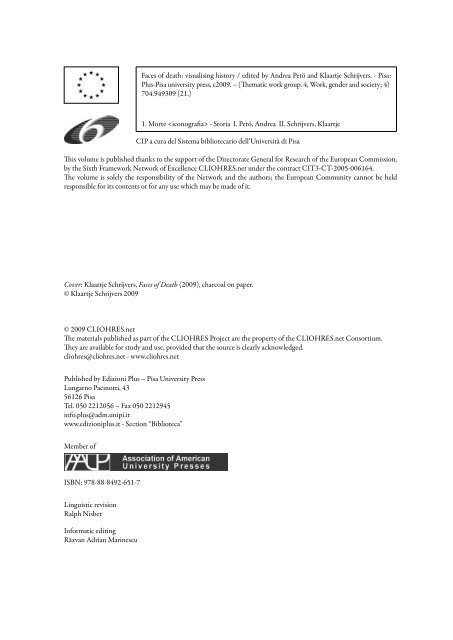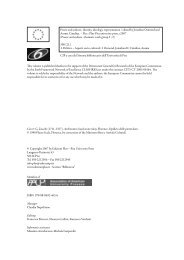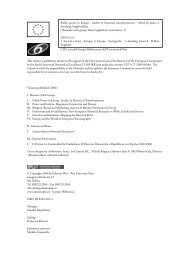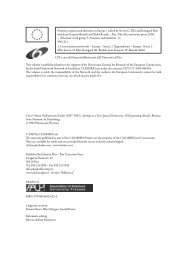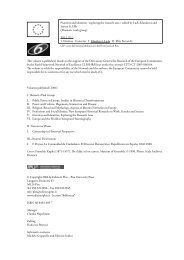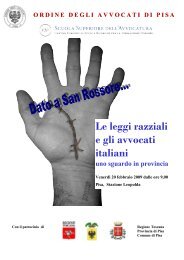Faces of death: visualising history / edited by ... - CLIOHRES.net
Faces of death: visualising history / edited by ... - CLIOHRES.net
Faces of death: visualising history / edited by ... - CLIOHRES.net
Create successful ePaper yourself
Turn your PDF publications into a flip-book with our unique Google optimized e-Paper software.
<strong>Faces</strong> <strong>of</strong> <strong>death</strong>: <strong>visualising</strong> <strong>history</strong> / <strong>edited</strong> <strong>by</strong> Andrea Petö and Klaartje Schrijvers. - Pisa:<br />
Plus-Pisa university press, c2009. – (Thematic work group. 4, Work, gender and society; 4)<br />
704.949309 (21.)<br />
1. Morte - Storia I. Petö, Andrea II. Schrijvers, Klaartje<br />
CIP a cura del Sistema bibliotecario dell’Università di Pisa<br />
This volume is published thanks to the support <strong>of</strong> the Directorate General for Research <strong>of</strong> the European Commission,<br />
<strong>by</strong> the Sixth Framework Network <strong>of</strong> Excellence <strong>CLIOHRES</strong>.<strong>net</strong> under the contract CIT3-CT-2005-006164.<br />
The volume is solely the responsibility <strong>of</strong> the Network and the authors; the European Community cannot be held<br />
responsible for its contents or for any use which may be made <strong>of</strong> it.<br />
Cover: Klaartje Schrijvers, <strong>Faces</strong> <strong>of</strong> Death (2009), charcoal on paper.<br />
© Klaartje Schrijvers 2009<br />
© 2009 <strong>CLIOHRES</strong>.<strong>net</strong><br />
The materials published as part <strong>of</strong> the <strong>CLIOHRES</strong> Project are the property <strong>of</strong> the <strong>CLIOHRES</strong>.<strong>net</strong> Consortium.<br />
They are available for study and use, provided that the source is clearly acknowledged.<br />
cliohres@cliohres.<strong>net</strong> - www.cliohres.<strong>net</strong><br />
Published <strong>by</strong> Edizioni Plus – Pisa University Press<br />
Lungarno Pacinotti, 43<br />
56126 Pisa<br />
Tel. 050 2212056 – Fax 050 2212945<br />
info.plus@adm.unipi.it<br />
www.edizioniplus.it - Section “Biblioteca”<br />
Member <strong>of</strong><br />
ISBN: 978-88-8492-651-7<br />
Linguistic revision<br />
Ralph Nisbet<br />
Informatic editing<br />
Răzvan Adrian Marinescu
Facing Death on the Sea. Ex-voto<br />
Paintings <strong>of</strong> Northern Adriatic Sailing<br />
Ships in the 19th Century<br />
Tea Mayhew<br />
Maritime and History Museum <strong>of</strong> the Croatian Littoral, Rijeka<br />
Abstract<br />
The aim <strong>of</strong> this chapter is investigate maritime votive, or ‘ex-voto’, paintings as a source<br />
for the <strong>history</strong> <strong>of</strong> mentality, creating a store <strong>of</strong> imagery inspired <strong>by</strong> <strong>death</strong> and mortal<br />
danger in specific conditions <strong>of</strong> life on the sea. We focus on 16 pictures <strong>of</strong> 19th-century<br />
sailing ships from the northern-east Adriatic. The paintings were from votive chapels:<br />
from the small village <strong>of</strong> Kraj on the eastern Istrian coast, Mali Lošinj on the island<br />
<strong>of</strong> Lošinj and the Franciscan monastery on Trsat (Rijeka). In addition, there are some<br />
paintings from the collection <strong>of</strong> the Maritime and History Museum <strong>of</strong> the Croatian<br />
Littoral, Rijeka. Here we present the way in which they transmitted messages <strong>of</strong> everyday<br />
life and danger as experienced <strong>by</strong> sailors throughout the world’s seas. The paintings<br />
are observed as a means <strong>of</strong> communication <strong>by</strong> sailors and their families on the coastland<br />
as well as presenting personal histories.<br />
Smisao je ovog članka istražiti pomorske zavjetne slike ili ex-vota kao izvor za istraživanje<br />
povijesti mentaliteta, stvaranja mentalnih slika potaknutih smrću i smtrnom opasnošću<br />
u specifičnim uvjetima života na moru. Usredotočit ćemo se na 16 slika nastalih u 19.<br />
stoljeću, koje prikazuju jedrenjake sjeveroistočne obale Jadrana. Odabrane slike nalaze se u<br />
zavjetnim kapelama u malom selu kraj na istočnoj obali Istre, Malom Lošinju i u franjevačkom<br />
samostanu na Trsatu (Rijeka). Dodatno su razmatrane i slike iz zbirke Pomorskog<br />
i povijesnog muzeja Hrvatskog primorja Rijeka. Ovi vizualni povijesni izvori ovdje će biti<br />
predstavljeni kao sredstva prenošenja poruke svakodnevnog života i opasnosti koju su iskusili<br />
pomorci ploveći morima svijeta. Slike su razmatrane kao oblik komunikacije između<br />
mornara i njihovih obitelji na obali kao i sredstvo predstavljanja njihove osobne povijesti.<br />
One <strong>of</strong> my vivid memories from school literature is the dramatic scene <strong>of</strong> a shipwreck<br />
described <strong>by</strong> a 19th-century Croatian writer Eugen Kumičić in his book Začuđeni sva-
208<br />
Tea Mayhew<br />
tovi [Wedding Astonishment]. He was inspired <strong>by</strong> an event which took place in the<br />
channel between his small hometown <strong>of</strong> Brseč and the island <strong>of</strong> Cres when a sailing<br />
ship was caught in a storm and smashed to pieces against the steep coastal cliffs with<br />
only a few members <strong>of</strong> the crew surviving thanks to the help <strong>of</strong> the local people. Later<br />
on in life I had to cross the same channel for work and pleasure between the island <strong>of</strong><br />
Cres and the Istrian coastland known as Vela Vrata [Great Gate] as described in Eugen<br />
Kumičić’s novel and I nearly always reflected upon his description <strong>of</strong> the shipwreck and<br />
storm when I looked at the gorgeous cliffs below Brseč. More memorable still, on a few<br />
<strong>of</strong> my sailings across Vela Vrata the ferry was caught in a storm. Even a person with the<br />
slightest religious feelings at that kind <strong>of</strong> moment with the ship going up and down,<br />
left and right, with the waves crashing overboard, threatening to pull the ship to the<br />
bottom, would be inspired to think that there must be some ‘higher power’ to save the<br />
ship and a tiny human life from the ‘sea’s jaws’.<br />
In the villages on the eastern Istrian coast from Brseč to Lovran there are chapels with<br />
ex-voto paintings. The paintings show the ships on which local people served and faced<br />
<strong>death</strong> during rough weather or accidents. Thankful for their own survival and well aware<br />
how thin the line between life and <strong>death</strong> is for someone caught in a storm, they <strong>of</strong>fered<br />
their stories to local painters, or painted them themselves, and gave rise to the paintings<br />
which decorate the modest coastal chapels. The intentions <strong>of</strong> these special <strong>of</strong>ferings<br />
left on altars or hung on walls were usually prayers for the protection <strong>of</strong> a loved one<br />
on the sea or expressing gratitude for miraculous survival at sea. These two intentions<br />
twinned with a need for self presentation as well as decoration <strong>of</strong> the church interior 1 .<br />
These chapels are usually <strong>of</strong> small dimensions, built on the seashore or on cliffs with<br />
sea views, dedicated to the Virgin Mary as the mother figure and protector <strong>of</strong> sailors or<br />
very <strong>of</strong>ten to St. Nicolas who is also a protector <strong>of</strong> sailors and travellers 2 . The paintings<br />
have occasionally been studied <strong>by</strong> art historians and historians interested in the <strong>history</strong><br />
<strong>of</strong> religious cults 3 . Being a part <strong>of</strong> popular culture, ex-voto paintings and other ex-voto<br />
items provide a rich source for the <strong>history</strong> <strong>of</strong> everyday life and perceptions <strong>of</strong> <strong>death</strong>,<br />
fear and belief as well as individual and collective identity 4 . Here we will only take into<br />
account paintings representing life and <strong>death</strong> on the sea in order to narrow the broad<br />
canvas <strong>of</strong> ex-voto phenomena. The ex-voto paintings <strong>of</strong> ships presented here come from<br />
the Chapel <strong>of</strong> Our Lady in the village <strong>of</strong> Kraj, the shrine <strong>of</strong> Our Lady <strong>of</strong> Trsat in Rijeka<br />
and the Church <strong>of</strong> Our Lady in Veli Lošinj on the island <strong>of</strong> Lošinj. Similar chapels can<br />
be found all around the Adriatic coast and the Mediterranean in general. In order to<br />
give a broader insight into the visual memories <strong>of</strong> sailing ships and their crews caught<br />
in different sorts <strong>of</strong> danger at sea, we have also used paintings preserved in the Maritime<br />
and History Museum <strong>of</strong> the Croatian Littoral, Rijeka. The intention is to explore<br />
how this kind <strong>of</strong> visual material can be used as a primary historical source, and more<br />
precisely as a source for the <strong>history</strong> <strong>of</strong> collective and individual perceptions <strong>of</strong> <strong>death</strong><br />
and survival from mortal danger as they arise in everyday life. In other words, from my
Facing Death on the Sea 209<br />
personal experience <strong>of</strong> danger on rough seas to observing the paintings on the chapels’<br />
walls, my aim is to scan the visual rhetoric <strong>of</strong> maritime ex-voto paintings as a means <strong>of</strong><br />
identification, empathy with another through recognition <strong>of</strong> deep emotional experience,<br />
and transmission <strong>of</strong> experience from one generation to the next 5 .<br />
Images always have a strong role in generating religious experience 6 and act in two ways:<br />
first as the expression <strong>of</strong> a religious experience and second to (re)awaken religious feelings<br />
in the observer <strong>by</strong> investing a sensational event with explicit messages: this was<br />
what happened to me – believe it! 7 The fact that ex-voto paintings are closely related to<br />
the promotion and maintenance <strong>of</strong> popular religion should not be ignored although<br />
they will not be deeply explored in this light here.<br />
Navigare necesse est, vivere non<br />
Given the large number <strong>of</strong> maritime ex-voto paintings and their existence in so many<br />
different places, it was necessary here to set a historical and geographical framework:<br />
to concentrate only on a small area and a relatively short period <strong>of</strong> maritime <strong>history</strong> <strong>of</strong><br />
the Northern Adriatic. I thus present only paintings <strong>of</strong> sailing ships, all from the 19th<br />
century, when these were still in widespread use in the northern Adriatic, enjoying a<br />
Fig. 1<br />
The Austrian Barque Maria Francika.<br />
An Artistic Representation
210<br />
Tea Mayhew<br />
short hour <strong>of</strong> glory before their demise with the development <strong>of</strong> the steamship 8 . The<br />
number <strong>of</strong> sailing ships reached a peak in the middle <strong>of</strong> the 19th century. The industrial<br />
revolution, trade and transport <strong>of</strong> goods and people took ships from Europe to all other<br />
continents. In our minds there is a romantic image <strong>of</strong> a sailing ship with the wind full<br />
in its sails, optimistically setting <strong>of</strong>f on a trip round the world 9 .<br />
The painting <strong>by</strong> Giovanni Luzzo in Venice 1862 represents the Austrian ship Maria<br />
Francika (port <strong>of</strong> origin Rijeka) sailing in front <strong>of</strong> the city <strong>of</strong> Venice (Fig. 1). This romantic<br />
vision <strong>of</strong> a happily sailing ship, which we can imagine on exciting trips from one port<br />
<strong>of</strong> the world to another, is interrupted in this painting <strong>by</strong> a smaller insert (lower middle)<br />
which shows the same barque Maria Francika during a storm, covered with huge waves,<br />
dangerously keeling over on its right side. Next to it can be seen another smaller vessel<br />
again engulfed in the waves. Unfortunately the text below the painting does not give<br />
any explanation <strong>of</strong> the danger, which the Maria Francika obviously survived though we<br />
do not know with how much damage. We can only conclude that for the person who<br />
ordered this painting it was necessary to emphasise that the ship survived a terrifying<br />
experience as shown in the little picture, which was probably perceived as a regular part<br />
<strong>of</strong> a sailor’s life 10 . The insert serves the purpose <strong>of</strong> completing the presentation <strong>of</strong> sailors’<br />
everyday life: a small contribution to the social construction <strong>of</strong> reality.<br />
Sailing ships depended on the wind and they used the usual corridors, which although<br />
well-known in the mid 19th century, always held some hidden dangers such as reefs,<br />
cliffs and storms. One <strong>of</strong> the most dangerous points where the passage <strong>of</strong> sailing ship<br />
was known to be a hazard was Cape Horn in South America. Amongst seamen Cape<br />
Horn is known as the most unsettled part <strong>of</strong> the Earth where warm and cold currents<br />
mix and the weather is almost completely unpredictable. Storms and high winds can<br />
smash a ship on the sharp cliffs <strong>of</strong> Tierra del Fuego. Alternatively, it may hit an iceberg<br />
or another ship, invisible in the mist – again enough to cause sinking. Although well<br />
aware <strong>of</strong> these dangers, some sailing ships <strong>of</strong> steel construction kept up a regular connection<br />
between Europe and the western coast <strong>of</strong> America before the Panama Canal<br />
was built. Those who survived the rounding <strong>of</strong> Cape Horn were deemed especially skilful<br />
seamen, not to say blessed 11 . Some <strong>of</strong> their memories <strong>of</strong> terrifying experiences have<br />
also been preserved in paintings.<br />
The Austro-Hungarian barque named Marietta W. (port <strong>of</strong> origin: Rijeka) can be seen<br />
in the painting again made <strong>by</strong> Giovanni Luzzo in Venice in 1869 (Fig. 2). The painting<br />
was ordered <strong>by</strong> the captain <strong>of</strong> the ship on behalf <strong>of</strong> the whole crew after they had successfully<br />
rounded Cape Horn on their way from Montevideo to Callao on 22 December<br />
1869, as can be seen from the inscription underneath (Nave Austriaca Marietta W.<br />
Commandata dal Capitano P. P. Potrata a Capo Horn 22. 12. 1869. da Montevideo per<br />
Callao.) It is not known whether the painting was meant to be placed in a chapel as a<br />
votive <strong>of</strong>fering for surviving the Cape Horn passage 12 . But in any case, surviving Cape<br />
Horn was something that deserved to be shown in paintings as a common means <strong>of</strong>
Facing Death on the Sea 211<br />
Fig. 2<br />
Austro-Hungarian sailing ship Marietta W.<br />
communicating memories. In a culture <strong>of</strong> limited literacy this picture would provide<br />
more evidence 13 than a captain’s report or ship’s diary.<br />
The other most dangerous point for a sailing ship in the 19th century was the western<br />
coast <strong>of</strong> Australia. The seabed is full <strong>of</strong> hidden reefs in this area, which were not wellknown<br />
<strong>by</strong> European mariners and were poorly described in their navigational charts.<br />
Thus they became the cause <strong>of</strong> numerous castaways 14 . In October 1875 the Austro-<br />
Hungarian sailing ship Stefano (port <strong>of</strong> origin: Rijeka) sailed from Cardiff to Hong<br />
Kong. The usual sailing route led north from the western Australian coast but every<br />
shipping route was mostly dictated <strong>by</strong> winds, which could bring a ship dangerously<br />
close to the coast. This is exactly what happened to the crew <strong>of</strong> the Stefano. They hit<br />
a reef near Point Cloates and the vessel sank in a very short time. However, ten members<br />
<strong>of</strong> the crew managed to reach the beach a few miles away where they began their<br />
fight for survival on the hostile Australian coastland. Most <strong>of</strong> them died <strong>of</strong> hunger and<br />
exhaustion 15 . Thanks to the help <strong>of</strong> a local aboriginal tribe the 16 year-old midshipman<br />
Miho Bačić and 19 year-old crewman Ivan Jurić were the only two who survived.<br />
The aborigines enabled them to get in contact with Captain Tucker who commanded<br />
the British cutter Jessie and helped them to return to civilisation, first to the European<br />
colony town <strong>of</strong> Fremantle and later back to Dalmatia. On their return to their homeland<br />
– Miho Bačić was from Dubrovnik and Ivan Jurić was from a village on the near<strong>by</strong><br />
An Artistic Representation
212<br />
Tea Mayhew<br />
Fig. 3<br />
The two survivors <strong>of</strong> the Stefano<br />
peninsula <strong>of</strong> Pelješac – they recounted their dramatic story to a Dominican brother<br />
named Stjepo Skurla who wrote down their memoirs 16 . In addition, they ordered an<br />
ex-voto painting <strong>of</strong> their miraculous survival.<br />
This painting does not represent their lost ship, the Stefano. In gratitude to the Aborigines<br />
and the Virgin Mary (shown in the upper left-hand corner <strong>of</strong> the picture) they<br />
commissioned a painting showing the beach scene where aboriginal tribes escorted<br />
them to the cutter Jessie 17 (Fig. 3). Painted from their memory, the picture became a<br />
visual medium conveying the individual’s personal <strong>history</strong> or <strong>history</strong> ‘from below’ 18 .<br />
Despite his terrifying experience on that first trip on the Stefano, Miho Bačić returned<br />
to his vocation as a seaman. Only three years after his salvation in Australia he became<br />
a captain and sailed on a ship belonging to his uncle Niko Bačić 19 .<br />
Great oceans and unknown seas were not the only places where ships could suffer<br />
storms. Storms, great waves and cliffs were dangerous even in relatively shallow and<br />
peaceful seas such as the Adriatic.<br />
The following painting shows the sailing ship Sattor near the islet <strong>of</strong> Susak, just a few<br />
miles from its home port on the island <strong>of</strong> Lošinj caught in a fortunale [sudden storm at
Facing Death on the Sea 213<br />
Fig. 4<br />
The Sattor.<br />
sea] (Fig. 4). According to the inscription below the painting, the ship was under the<br />
command <strong>of</strong> Captain Mate Perović when the event happened on 18 December 1892 20 .<br />
Although the sky in the picture is relatively clear, it is obvious that the wind is lifting<br />
high waves and the vessel is about to be engulfed <strong>by</strong> sea coming in from the left while<br />
the right side is yawing dangerously. Three members <strong>of</strong> the crew are shown in the stern<br />
holding the rails. There is no more information about this fortunale or any damage to<br />
the Sattor or its crew, but some other written documents provide us with the information<br />
that this ship suffered various other accidents. In 1875 on its way from Odessa to<br />
Grims<strong>by</strong> and Hull, the Sattor collided with a steamship sailing on the River Humber,<br />
which caused some damage to its sails. In 1887 on the way from Cagliari to Philadelphia<br />
the Sattor ran aground on the Schuykill but without incurring any major damage.<br />
In 1892 when on its way back from Algeria to Lošinj the Sattor survived a collision<br />
with the Italian schooner named Maria R. in which both ships were heavily damaged<br />
and the Sattor had to be towed to its homeport <strong>of</strong> Lošinj 21 .<br />
Another Austrian vessel, the Maria Andrina (amongst whose owners was Marija Car,<br />
widow <strong>of</strong> Captain Srećko Vlašić, from the town <strong>of</strong> Bakar) suffered multiple sea damage.<br />
On its first trip in December 1879 from the Marmara Sea to Le Havre its captain<br />
An Artistic Representation
214<br />
Tea Mayhew<br />
Celestin Katnić was caught in a powerful Atlantic storm. The ship suffered major damage,<br />
all the crew were lost and the ship limped into the shelter <strong>of</strong> the port <strong>of</strong> Lisbon.<br />
In 1883 the Maria Andrina was once again caught in a heavy storm on its way from<br />
Trieste to Bordeaux and lost all <strong>of</strong> its cargo (mostly wood). In 1885 the Maria Andrina<br />
became beached on the island <strong>of</strong> Cres (just opposite the city <strong>of</strong> Rijeka). The ship was<br />
actually stranded <strong>by</strong> a strong wind from the northeast known as the bora. The Maria<br />
Andrina ended her existence tragically near the port <strong>of</strong> Trieste on 26 December 1890.<br />
Arriving there full <strong>of</strong> wood and rum a day after Christmas, she was forced <strong>by</strong> port procedure<br />
to wait before entering the harbour and anchored a few miles <strong>of</strong>fshore. During<br />
the night a strong wind pulled the ship from its anchor and waves forced it out to sea.<br />
The crew were aboard. In the meantime the wind and waves damaged the hull which<br />
sprang many leaks. After two days <strong>of</strong> fighting against the sea, the crew decided to save<br />
their lives <strong>by</strong> jumping into the sea and swimming to land. The steamship Iris rescued six<br />
<strong>of</strong> them, whilst another four (a deck <strong>of</strong>ficer from Rijeka, a black man from Mexico and<br />
two Frenchmen, the skipper and a kitchen assistant) were never found 22 .<br />
Fig. 5<br />
The Maria Andrina.<br />
The ex-voto painting <strong>of</strong> the Maria Andrina (Fig. 5) was made as a votive gift to the<br />
Virgin Mary <strong>of</strong> Trsat and was placed in the votive chapel <strong>of</strong> the Franciscan monastery at<br />
Trsat (Rijeka). The painting shows the vessel, under the command <strong>of</strong> Captain L. Mates-
Facing Death on the Sea 215<br />
sich, near the Lizard Point in the Atlantic Ocean during a tempest. In the far distance<br />
can be seen a lighthouse, lending hope <strong>of</strong> salvation. The inscription below the painting<br />
gives some explanation <strong>of</strong> the situation. The ship suffered damage to its hull and water<br />
was coming in, while the crew laboured to pump it out.<br />
A storm might not cause any damage to a ship, but the loss <strong>of</strong> cargo and food supplies<br />
was dangerous enough for the crew. Loss <strong>of</strong> food and water supplies on board a ship in<br />
the middle <strong>of</strong> the ocean with no possibility <strong>of</strong> reaching the coast meant that their only<br />
hope would be if another ship passed <strong>by</strong>.<br />
Fig. 6<br />
The Descovich A.<br />
This ex-voto painting (Fig. 6) represents the sailing ship Descovich A. almost completely<br />
covered with waves. The sails are damaged, some <strong>of</strong> the crew are at the stern and some<br />
<strong>of</strong> them are at the bow trying to save the situation. In the sea are parts <strong>of</strong> cargo: wood<br />
and barrels. The event happened on the stormy night <strong>of</strong> 27-28 January 1878 en route<br />
from Sardinia to the Balearic islands. The crew members who survived commissioned<br />
this votive painting as an <strong>of</strong>fering to the Virgin Mary <strong>of</strong> Trsat (Rijeka). It is preserved in<br />
the votive chapel <strong>of</strong> the Franciscan Brothers <strong>of</strong> Trsat.<br />
Life aboard ship itself included high risks such as those caused <strong>by</strong> specific cargos like<br />
oil and coal, cooking with open fires, having low hygiene standards and poor nutrition<br />
which caused various illnesses. Besides this, there was also the danger <strong>of</strong> being attacked<br />
An Artistic Representation
216<br />
Tea Mayhew<br />
and/or kidnapped <strong>by</strong> pirates. These factors put a seamen’s life at risk or to use the expression<br />
<strong>of</strong> Jean Piere Filippini, <strong>death</strong> was near them 23 . According to an estimate made<br />
<strong>by</strong> Alberto Cosulich, one in every three ships was lost in the 18th and 19th centuries,<br />
while the other two survived some less dangerous hazards 24 . This can also be reconstructed<br />
from maritime documents such as <strong>of</strong>ficial ship’s diaries or maritime shipping<br />
registers. Other written sources are the documents <strong>of</strong> inquiries <strong>by</strong> authorities following<br />
shipping accidents, including the testimony <strong>of</strong> survivors. But these are ‘dry facts’ which<br />
do not provide information about the subjective experience <strong>of</strong> life aboard ship. A seaman<br />
was usually a simple man who was most <strong>of</strong>ten illiterate or if capable <strong>of</strong> writing was<br />
rarely called upon to use it. To tell a skilful painter the story <strong>of</strong> their survival and challenges<br />
encountered on the sea was the only way to preserve the memory <strong>of</strong> the event.<br />
Painting was also the only way to tell their stories to others who were not used to reading.<br />
In this way seamen visualised their experiences through paintings and in doing so<br />
expressed their religious feelings, all <strong>of</strong> which helped them to continue their life at sea 25 .<br />
These paintings formed a memory <strong>of</strong> them and their dearest left on the coast. Ex-voto<br />
paintings created a bridge between a chaotic and unpredictable life at sea, punctuated<br />
<strong>by</strong> storms and other fatal dangers, and survival as part <strong>of</strong> the intention <strong>of</strong> a higher divine<br />
power felt as a blessing, the blessing <strong>of</strong> being alive 26 .<br />
Visual memory <strong>of</strong> near-<strong>death</strong> and suffering<br />
Ex-voto paintings have a long tradition in Christianity. They are actually a continuity<br />
<strong>of</strong> the oldest religious expression – <strong>of</strong>fering <strong>of</strong> a gift to god(s). Votive paintings spread<br />
from the 14th century onwards as thanksgiving for an answered prayer and developed<br />
as a kind <strong>of</strong> popular culture, as opposed to elitist Renaissance and Baroque art 27 . A votive<br />
painting did not need to be glamorous. The representation <strong>of</strong> a deadly dangerous<br />
situation was more important than questions <strong>of</strong> style and a painter was just a transmitter<br />
<strong>of</strong> information about such events. Thus this kind <strong>of</strong> painting was not influenced <strong>by</strong> the<br />
various art styles. It was related to the development <strong>of</strong> visual language as a specific means<br />
<strong>of</strong> communicating past events 28 . Amongst the large number <strong>of</strong> anonymous creators <strong>of</strong><br />
maritime ex-voto paintings on the Eastern Adriatic, those who made their painting a<br />
pr<strong>of</strong>ession and who signed their paintings were Bazilije Baltazar Ivanković and Giovanni<br />
Luzzo. Baltazar Ivanković, who was a successful and educated painter, was also a captain<br />
who experienced life on ship. Nevertheless there are great numbers <strong>of</strong> paintings whose<br />
authors are unknown or without any artistic education 29 . The absence <strong>of</strong> any signature<br />
on a painting denotes the importance <strong>of</strong> the event represented and not the artist.<br />
This ex-voto painting, dominated <strong>by</strong> dark colours to emphasise the dramatic atmosphere,<br />
shows a ship which is just about to be engulfed <strong>by</strong> a huge wave (Fig. 7). In the<br />
distance is another ship in a similar plight. In the sky <strong>of</strong> the painting appears the figure<br />
<strong>of</strong> the Virgin Mary. From the inscription below, we learn that its captain, Eustachio
Facing Death on the Sea 217<br />
Fig. 7<br />
Anonymous sailing ship.<br />
Sieni, ordered this painting to be made after his ship was saved from three hurricanes in<br />
mid ocean in November 1858. The author <strong>of</strong> the painting is anonymous as is the name<br />
<strong>of</strong> the vessel 30 . Again, the symbolical meaning <strong>of</strong> an ex-voto surpasses the need for realistic<br />
reconstruction or representation <strong>of</strong> the event. Its aim is to preserve and transmit<br />
the meaning <strong>of</strong> the event itself.<br />
However, some customs were nearly always followed in ex-voto paintings. The votive<br />
painting usually represents the person who was blessed i.e. saved, the event and the saint<br />
who helped the person. The painting is very <strong>of</strong>ten followed <strong>by</strong> short writings about the<br />
event.<br />
This painting <strong>by</strong> an anonymous author (Fig. 8), who to judge <strong>by</strong> the naïf presentation <strong>of</strong><br />
a seaman on the ship and the figure <strong>of</strong> the Virgin Mary and child, both holding rosaries<br />
in their hands, was not an educated artist, can be taken as a typical ex-voto presenting<br />
An Artistic Representation
218<br />
Tea Mayhew<br />
Fig. 8<br />
Austrian pileage called Cattone.<br />
all the features: the figure <strong>of</strong> a saint protector, emphasis on the scene <strong>of</strong> the sinking<br />
ship and pathos with the usage <strong>of</strong> dark colours, the people with unrecognisable faces<br />
and figures but depicted in movement which contributes to the dynamics <strong>of</strong> the event,<br />
and a written explanation <strong>of</strong> the event underneath the painting. From the inscription<br />
we learn that the ship – an Austrian pileage called Cattone under the command <strong>of</strong> its<br />
owner Giovanni Minach – was in immediate danger <strong>of</strong> sinking while sailing from Lido<br />
to Trieste against a very strong wind and mounting waves. The crew had to throw some<br />
cargo overboard in order to save their lives, and they also lost a lifeboat. The event happened<br />
on 10 January 1845. The painting was <strong>of</strong>fered as a gift to the Virgin Mary and is<br />
still on the wall <strong>of</strong> the votive chapel in Trsat (Rijeka).<br />
The presence <strong>of</strong> a protecting saint (most <strong>of</strong>ten the Virgin Mary) to whom prayers for<br />
salvation were dedicated is a common feature <strong>of</strong> ex-voto paintings. The meaning <strong>of</strong> this<br />
figurative presentation <strong>of</strong> a patron saint is undoubtedly to express gratitude for salvation,<br />
which is very common in popular Catholic belief 31 . Absence <strong>of</strong> a human figure as<br />
saint protector may be substituted, in more sophisticated paintings, <strong>by</strong> the appearance<br />
<strong>of</strong> a clear patch or a ray <strong>of</strong> light on a very dark stormy sky.
Facing Death on the Sea 219<br />
Fig. 9<br />
The Genio.<br />
The ex-voto painting <strong>of</strong> the sailing vessel Genio (Fig. 9) was painted in an artistic way,<br />
where the dramatic atmosphere is emphasised <strong>by</strong> very dark grey colours; the clear patch<br />
in the sky indicates the imaginary place from which the blessing came. This ship was<br />
saved from a storm while sailing near the Irish coast on its way from Alexandria to<br />
Cork. The grateful Captain Kuzma Randić ordered the painting on behalf <strong>of</strong> his crew<br />
who were saved in October 1867. Again we note that the symbolic meaning <strong>of</strong> an exvoto<br />
is more important than realistic reconstruction or representation <strong>of</strong> the event 32 .<br />
The painting is preserved in the votive chapel <strong>of</strong> the monastery <strong>of</strong> Trsat.<br />
A painting can become votive simply through the intention <strong>of</strong> the one who ordered it<br />
and placed it in a chapel as an <strong>of</strong>fering and reminder to those who stayed at home <strong>of</strong> those<br />
who left for good. In this way the ex-voto acted as a symbolic communication between<br />
seamen and their families, as well as those who lost their lives in the depths <strong>of</strong> the sea.<br />
This painting from the Chapel <strong>of</strong> the Virgin Mary in the fishing village <strong>of</strong> Kraj does not<br />
bear any record <strong>of</strong> the name <strong>of</strong> the ship or author and the inscription in the Croatian<br />
language at the top <strong>of</strong> the painting has faded (Fig. 10). It can only be understood that<br />
this was a ship caught in a heavy storm in the English Channel. The vessel was completely<br />
engulfed <strong>by</strong> waves, whilst a lifeboat can be seen leaving with the crew and further<br />
away can be seen a steamship which may possibly have helped in saving the crew 33 .<br />
An Artistic Representation
220<br />
Tea Mayhew<br />
Fig. 10<br />
Painting from the village <strong>of</strong> Kraj.<br />
In the composition <strong>of</strong> the picture the accent is on the details <strong>of</strong> the event. Painters <strong>of</strong>ten<br />
used colours to emphasise dramatic atmosphere. This was very <strong>of</strong>ten the case with<br />
maritime ex-voto paintings 34 .<br />
The following painting was made <strong>by</strong> Giovanni Petz from the town <strong>of</strong> Lovran on his<br />
own behalf and that <strong>of</strong> three survivors from the schooner Ninfa which was caught in a<br />
hurricane on 21 December 1855 (Fig. 11). During this event four <strong>of</strong> the people from<br />
the ship were lost in the sea. The survivors also mention their names on the painting:<br />
Captain Enrico Malco<strong>net</strong>ti, clerk Giovanni Scomparini, camarotto Giovanni Thich and<br />
mariner Mattio Mittrovich. They also mention that one mariner died later in the hospital<br />
in Constantinople. The painting was dedicated to the Virgin Mary <strong>of</strong> Trsat to whom<br />
the mariners prayed during the drama.<br />
Authenticity <strong>of</strong> ex-voto paintings<br />
The main intention <strong>of</strong> ex-voto paintings – to narrate dramatic events – has its full expression<br />
in representations <strong>of</strong> sea hazards. The expressive representation <strong>of</strong> a ship or<br />
castaway in a storm aims to give a vivid impression to an audience without any preconceptions<br />
35 . Ex-voto paintings <strong>of</strong>ten contain numerous visual details <strong>of</strong> the ship, position<br />
and activities <strong>of</strong> the crew and degree <strong>of</strong> damage to the ship.
Facing Death on the Sea 221<br />
Fig. 11<br />
The Schooner Ninfa.<br />
The next painting shows the sailing vessel Spirito (port <strong>of</strong> origin Rijeka) caught in a<br />
tempest (Fig. 12). The crew are trying to throw the cargo <strong>of</strong> wood overboard, while a<br />
wave tugs away the lifeboat from the mother ship. The author <strong>of</strong> the painting paid great<br />
attention to realistic depiction <strong>of</strong> the rough sea and stormy sky. Every part <strong>of</strong> the ship is<br />
also meticulously painted, including the movements <strong>of</strong> the crew 36 .<br />
Such paintings stress authenticity, and tend to be followed <strong>by</strong> a short script, usually at<br />
the bottom <strong>of</strong> the painting. This information <strong>of</strong>ten includes the geographical position<br />
<strong>of</strong> the ship, the name <strong>of</strong> the captain, the time and possibly the name <strong>of</strong> the saint to<br />
whom the <strong>of</strong>fering was dedicated. It might include the shrine, and provide information<br />
about the origins <strong>of</strong> the crew. With their specific intention <strong>of</strong> realistically representing<br />
dramatic events, some ex-voto paintings <strong>of</strong> shipwrecks are the only preserved document<br />
<strong>of</strong> certain ships and people. It also needs to be borne in mind that, in the period<br />
before photography, painting was the only possible means <strong>of</strong> visual communication and<br />
broadcasting information. Indeed, ex-voto paintings are <strong>of</strong>ten the only information we<br />
have about maritime dangers, shipwrecks and accidents.<br />
An Artistic Representation
222<br />
Tea Mayhew<br />
Fig. 12<br />
The Spirito.<br />
Fig. 13<br />
The Olga R.
Facing Death on the Sea 223<br />
The following (Fig. 13) painting shows the Olga R., which never returned from its<br />
maiden voyage to the town <strong>of</strong> Bakar, its home port. This ex-voto painting dedicated<br />
to the Virgin Mary <strong>of</strong> Trsat was ordered <strong>by</strong> its grateful captain, Juraj Mikuličić, and his<br />
crew who survived a storm on 31 October 1881. The blessing coming from the sky is<br />
represented <strong>by</strong> a clear patch <strong>of</strong> sky and specks <strong>of</strong> light falling onto the ship. The crew are<br />
barely visible at the stern <strong>of</strong> the ship.<br />
Unlike other ex-voto paintings, those with maritime motifs do not put an individual’s<br />
survival in the foreground. The accent is completely on the event; in some cases the people<br />
themselves are missing or they are presented in minimal and unrecognisable form.<br />
Fig. 14<br />
The Brig Filomena.<br />
In the painting above (Fig. 14) the brig Filomena, under the command <strong>of</strong> Captain M.<br />
Segota, is caught in a hurricane near Livorno on 23 February 1879. Thanks to the brave<br />
people <strong>of</strong> Livorno the crew were saved and in gratitude for their rescue they ordered an<br />
ex-voto painting for the Chapel <strong>of</strong> the Virgin Mary <strong>of</strong> Trsat (Rijeka).<br />
Even when people are represented in a painting, they are just part <strong>of</strong> the whole scenery.<br />
The ship is a personification <strong>of</strong> the whole suffering crew. Here individuality is absent and<br />
the meaning is no longer private. The significance to the public <strong>of</strong> an ex-voto painting is<br />
additionally emphasised <strong>by</strong> public display in a church along with other ex-voto <strong>of</strong>ferings 37 .<br />
An Artistic Representation
224<br />
Tea Mayhew<br />
Fig. 15<br />
Chapel <strong>of</strong> the Virgin Mary in Trsat.<br />
Above we see the ex-votos in the votive Chapel <strong>of</strong> the Virgin Mary in the Franciscan<br />
monastery <strong>of</strong> Trsat (Rijeka). Some paintings <strong>of</strong> ships can be seen upper right <strong>by</strong> the window<br />
alongside models <strong>of</strong> sailing ships, which were another type <strong>of</strong> ex-voto (Fig. 15).<br />
There is another element to be taken into consideration and that is the way the situation<br />
is presented. As a historical source ex-voto paintings can be analysed as the representation<br />
simultaneously <strong>of</strong> survival or <strong>death</strong> and the way in which the survivors coped with the<br />
trauma <strong>of</strong> facing imminent <strong>death</strong> or maybe the loss <strong>of</strong> someone who is close to them.<br />
One thing can be noted when analysing maritime ex-voto paintings: there is no obvious<br />
representation <strong>of</strong> <strong>death</strong> in any <strong>of</strong> the pictures reported in this chapter. In ex-voto<br />
paintings the accent is on the dramatic situation, which may have led to human casualties,<br />
but here it is the ship that personifies human beings and survives the danger.<br />
This can also be interpreted as awareness <strong>of</strong> how vulnerable and insignificant human<br />
life is when confronted with the force <strong>of</strong> nature, here shown as the unpredictable sea.<br />
From a maritime ex-voto painting we may not be able to conclude who died, or even
Facing Death on the Sea 225<br />
those who survived. It may only be an additional text that provides such information.<br />
Here again, the accent is on the situation, the transmission <strong>of</strong> the atmosphere and<br />
pathos <strong>of</strong> a horrible predicament, which without any additional information tells the<br />
viewer that human lives were or could have been lost, that those who survived saw<br />
the ‘face <strong>of</strong> <strong>death</strong>’.<br />
Fig. 16<br />
The Clipper Royal Charter.<br />
The painting above shows a clipper sailing ship with an auxiliary steam engine, the<br />
Royal Charter, just before it sank in 1859 (Fig. 16). The text on the bottom <strong>of</strong> the<br />
painting is in English: “Loss <strong>of</strong> the Royal Charter”. The ship was beached on the coast<br />
<strong>of</strong> Wales on its way from Australia. 459 people drowned in this tragedy. In the painting<br />
people can be seen floating amid the wreckage <strong>of</strong> the ship, others still on its prow,<br />
and a lifeboat in the sea 38 . It is interesting to mention here that the ship did not have<br />
a direct connection with the village <strong>of</strong> Kraj, but the painting <strong>of</strong> its last voyage, executed<br />
in Frankfurt am Main and set in a decorative frame, found its place in the little<br />
Chapel <strong>of</strong> the Virgin Mary in Kraj, alongside other votive paintings.<br />
An Artistic Representation
226<br />
Tea Mayhew<br />
Maritime ex-votos as a <strong>history</strong> source<br />
Maritime ex-voto paintings have usually been studied as a specific popular or naïf form<br />
<strong>of</strong> painting, in cases where the author was anonymous and unschooled in art. Some votive<br />
paintings such as those made <strong>by</strong> the Croatian painter Baltazar Ivanković have been<br />
studied <strong>by</strong> art historians as works <strong>of</strong> art. Again, as previously mentioned, the authenticity<br />
and care for technical detail <strong>of</strong> the ship and the appended text, made ex-voto paintings<br />
an important source for the study <strong>of</strong> maritime <strong>history</strong>. This is something which can<br />
also be found in contemporary photographs <strong>of</strong> beached or wrecked sailing ships 39 . Of<br />
course, photography shows the straight facts, the remains <strong>of</strong> a ship, something left after<br />
the real dramatic event and the emotional climax had passed – precisely the focus <strong>of</strong><br />
the paintings. Nevertheless, votive paintings have not been studied as a <strong>history</strong> source<br />
for the perception <strong>of</strong> <strong>death</strong>, which was actually the hidden reason why the picture was<br />
created. Often facing <strong>death</strong> at sea, the seamen in these paintings placed the accent on<br />
their survival which, according to the statistics, was far from likely. Survival at sea during<br />
storms was completely out <strong>of</strong> the seamen’s hands. There was little chance <strong>of</strong> finding<br />
refuge, other than prayer and a belief in a ‘higher power’, which comes across in the<br />
paintings. The paintings are a source for understanding people who did not leave many<br />
written words after them. It is thus a pity that so many ex-voto paintings have been<br />
lost or stolen from votive chapels on the Eastern Adriatic coast. Others which have<br />
remained in their original places have been exposed to damp and neglect as well as<br />
vandalism, without respect for the people to whom this may be the only memorial or<br />
legacy left behind.<br />
Notes<br />
1<br />
D. Žitko, Ex-voto. Votivne podobe pomorcev [Ex-voto. Votive seamen images], Koper 1992, p. 8.<br />
2<br />
For more about ex-voto painting on the Eastern Adriatic coast see A. Kisić, Ex-voto Adriatico. Zavjetne<br />
slike hrvatskih pomoraca [Votive paintings <strong>of</strong> Croatian mariners], Zagreb 2005. More on ex-voto paintings<br />
from the Slovenian coastland <strong>of</strong> Istria with some reproductions <strong>of</strong> the most typical paintings will<br />
be found in Žitko, Ex-voto cit.<br />
3<br />
The maritime ex-voto paintings <strong>of</strong> the Eastern Adriatic have been studied very poorly <strong>by</strong> Croatian and<br />
Slovenian art historians. They have been studied mostly as exhibition material and published in exhibition<br />
catalogues while the ex-votos <strong>of</strong> the other side <strong>of</strong> the Adriatic (Italy) have been more pr<strong>of</strong>oundly<br />
studied, for example in the work <strong>of</strong> A. Tripputi, Ex-voto di Puglia. Cronache di vita quotidiana, Bari<br />
1999.<br />
4<br />
Ex-votos are presented as just such an important historiographical source in the book <strong>by</strong> B. Cousin, Le<br />
Miracle et le Quotidien: Les ex-voto provençaux images d’une société, Aix-en-Provence 1983.<br />
5<br />
D. Morgan, Visual piety. A History and Theory <strong>of</strong> Popular Religious Images, Berkeley 1999, pp. 5-12.<br />
The author emphasises that religious images, which should also include ex-voto paintings, are forms <strong>of</strong><br />
collective memory that afford the scholar primary documentation <strong>of</strong> the construction and transmission<br />
<strong>of</strong> everyday experience and a special ability to mediate the domains <strong>of</strong> imagery, language, intellect<br />
and matter.
Facing Death on the Sea 227<br />
6<br />
For a short account <strong>of</strong> visual sources and understanding the holy and supernatural see P. Burke, Eyewitnessing:<br />
The Uses <strong>of</strong> Images as Historical Evidence. For the purposes <strong>of</strong> this study I used a Croatian<br />
translation published in Zagreb 2003, pp. 47-59.<br />
7<br />
On sympathy and empathy in the visual expression <strong>of</strong> belief more will be found in D. Morgan, Visual<br />
Piety cit., pp. 58-60.<br />
8<br />
On the <strong>history</strong> <strong>of</strong> the last Northern Adriatic sailing ships see R.F. Barbalić, I. Marendić, Onput, kad smo<br />
partili [That time when we departed], Rijeka 2004.<br />
9<br />
R.F. Barbalić, Rijeka, Zagreb 1953, p. 106.<br />
10<br />
The painting is part <strong>of</strong> the collection <strong>of</strong> the Maritime and History Museum <strong>of</strong> the Croatian Littoral,<br />
Rijeka. The text below the picture says: Bark Francika Maria, comandato dal Capitano Antonio Segota<br />
Venezia 1862 [Barque “Francika Maria”, commanded <strong>by</strong> Captain Antonio Segota Venice 1862].<br />
11<br />
R.F. Barbalić, I. Jurković, Oploviti Cape Horn [Rounding Cape Horn], Rijeka 1975, pp. 17-46.<br />
12<br />
Today the painting is a part <strong>of</strong> the art collection <strong>of</strong> the Maritime and History Museum <strong>of</strong> the Croatian<br />
Littoral in Rijeka.<br />
13<br />
Burke, Eyewitnessing cit., p. 52, emphasised that in a culture <strong>of</strong> a limited literacy pictures are a richer<br />
evidence than any written material.<br />
14<br />
G. Henderson, K.-J. Henderson, Unfinished Voyages. Western Australian Shipwrecks 1851-1880, Nedlands,<br />
Western Australia 1988, pp. xiii-xviii.<br />
15<br />
Henderson, Unfinished Voyages cit., p. 177. The authors quote a part from the story written <strong>by</strong> Stjepo<br />
Skurla according to Miho Bačić’s and Ivo Jurić’s confessions: “Just over a week had passed since the<br />
natives left, when Bucich died. Baccich and Jurich realised the end was nearing – they must get food.<br />
Helping one another along they dragged themselves to their dead mate’s body and began savagely to<br />
tear pieces <strong>of</strong> flesh from it, swallowing it like animals. ‘You poor unfortunates, what are you doing!’<br />
gasped poor Dediol, and that was the last he spoke, possibly dying <strong>of</strong> shock as much as <strong>of</strong> starvation”.<br />
16<br />
This document is preserved in the Maritime and History Museum <strong>of</strong> the Croatian Littoral, Rijeka.<br />
17<br />
The painting was painted <strong>by</strong> Bazilije Bartol Ivanković in 1877.<br />
18<br />
About importance <strong>of</strong> visual sources for reconstruction <strong>of</strong> the ‘<strong>history</strong> from below’ see in Burke, Eyewitnessing<br />
cit., p. 52.<br />
19<br />
N. Mendeš, Stari jedrenjaci [Old sailing ships], Rijeka 2006, p. 25.<br />
20<br />
The painting is part <strong>of</strong> the collection <strong>of</strong> the Maritime and History Museum <strong>of</strong> the Croatian Littoral,<br />
Rijeka.<br />
21<br />
Barbalić, Marendić, Onput cit., p. 49.<br />
22<br />
Ibid., pp. 90-91.<br />
23<br />
J.P. Filippini, La pericolosità del mare e la religiosità del marinaio [Danger <strong>of</strong> the sea and religious feelings<br />
<strong>of</strong> a seaman], in A. Cosulich, I naufragi del ‘700 e del ‘800, Venezia 1986, p. 122.<br />
24<br />
Cosulich, I naufragi cit., p. 5.<br />
25<br />
Morgan, Visual Piety cit., p. 17, the author states that the meaning and power <strong>of</strong> popular religious imagery<br />
lies in the everyday domain <strong>of</strong> visual and epistemological recipes that guide people through the<br />
day or narrow escape from crises which shape their lives.<br />
26<br />
I. Rogić Nehajev, Slike iz usporedne povijesti [Pictures from a parallel <strong>history</strong>], in Barbalic, Marendić,<br />
Onput cit., pp. xii-xiii.<br />
27<br />
R. Ivančević, Leksikon ikonografije, liturgike i simbolike kršćanstva [Lexicon <strong>of</strong> iconography, liturgy and<br />
symbols <strong>of</strong> Christianity], Zagreb 1990, p. 225.<br />
28<br />
Kisić, Ex voto cit., p. 6.<br />
An Artistic Representation
228<br />
Tea Mayhew<br />
29<br />
Žitko, Ex-voto cit., p. 6.<br />
30<br />
The painting is a part <strong>of</strong> the collection <strong>of</strong> the Maritime and History Museum <strong>of</strong> the Croatian Littoral.<br />
31<br />
Cosulich, I naufragi cit., p. 120.<br />
32<br />
Ivančević, Leksikon cit., p. 61, emphasised that if an event was comprehended as a manifestation <strong>of</strong><br />
divine will, then only a symbolic presentation <strong>of</strong> the event would be enough to recall the feelings.<br />
33<br />
The photograph <strong>of</strong> this painting was taken <strong>by</strong> Pr<strong>of</strong>. Robert Mohović who also wrote more about this<br />
ship in the catalogue <strong>of</strong> the exhibition Ex-voto held in Mošćenice in 2006. I take this opportunity to<br />
thank Pr<strong>of</strong>. Mohović for his help in my research.<br />
34<br />
Kisić, Ex voto cit., pp. 6, 41.<br />
35<br />
Ibid., p. 41.<br />
36<br />
The painting forms part <strong>of</strong> the collection <strong>of</strong> the Maritime and History Museum <strong>of</strong> the Croatian Littoral,<br />
Rijeka.<br />
37<br />
Cosulich, I naufragi cit., p. 120.<br />
38<br />
R. Mohović, Ex-voto, catalogue <strong>of</strong> the exhibition, Mošćenice 2006, p. 16.<br />
39<br />
Coslulich mentioned that a large number <strong>of</strong> photographs <strong>of</strong> shipwrecks can be found in the National<br />
Maritime Museum <strong>of</strong> Greenwich (London). He also published some <strong>of</strong> them in his book I Naufragi<br />
cit., pp. 44, 49, 61-63, 65-66, 69-70, 73.<br />
Bibliography<br />
Barbalić R.F., Rijeka, Zagreb 1953.<br />
Id., Jurković I., Oploviti Cape Horn [Rounding Cape Horn], Rijeka 1975.<br />
Id., Marendić I., Onput, kad smo partili [That time when we departed], Rijeka 2004.<br />
Burke P., Eyewitnessing: The Uses <strong>of</strong> Images as Historical Evidence, Zagreb 2003.<br />
Cosulich A., I naufragi del ‘700 e del ‘800 [Shipwrecks <strong>of</strong> the 18th and 19th centuries], Venice 1986.<br />
Cousin B., Le Miracle et le Quotidien: Les ex-voto provençaux images d’une société, Aix-en-Provence 1983.<br />
Filippini J.P., La pericolosita del mare e la religiosita del marinaio [Dangerousness <strong>of</strong> the sea and religiosity<br />
<strong>of</strong> seamen], in Cosulich A., I naufragi del ‘700 e del ‘800 [Shipwrecks <strong>of</strong> the 18th and 19th centuries],<br />
Venice 1986.<br />
Henderson G., Henderson K.-J., Unfinished Voyages. Western Australian Shipwrecks 1851-1880, Nedlands,<br />
Western Australia 1988.<br />
Ivančević R., Leksikon ikonografije, liturgike i simbolike kršćanstva [Lexicon <strong>of</strong> iconography, liturgy and<br />
symbols <strong>of</strong> Christianity], Zagreb 1990.<br />
Kisić A., Ex-voto Adriatico. Zavjetne slike hrvatskih pomoraca [Votive paintings <strong>of</strong> Croatian mariners], Zagreb<br />
2005.<br />
Mendeš N., Stari jedrenjaci [Old sailing ships], Rijeka 2006.<br />
Mohović R., Ex-voto. Catalogue <strong>of</strong> the exhibition, Mošćenice 2006.<br />
Morgan D., Visual piety. A History and Theory <strong>of</strong> Popular Religious Images, Berkeley 1999.<br />
Rogić Nehajev I., Slike iz usporedne povijesti [Pictures from a parallel <strong>history</strong>], in Barbalic R.F., Marendić<br />
I., Onput, kad smo partili [That time when we departed], Rijeka 2004.<br />
Tripputi A., Ex-voto di Puglia. Cronache di vita quotidiana, Bari 1999.<br />
Žitko D., Ex-voto. Votivne podobe pomorcev [Ex-voto. Votive seamen images], Koper 1992.


